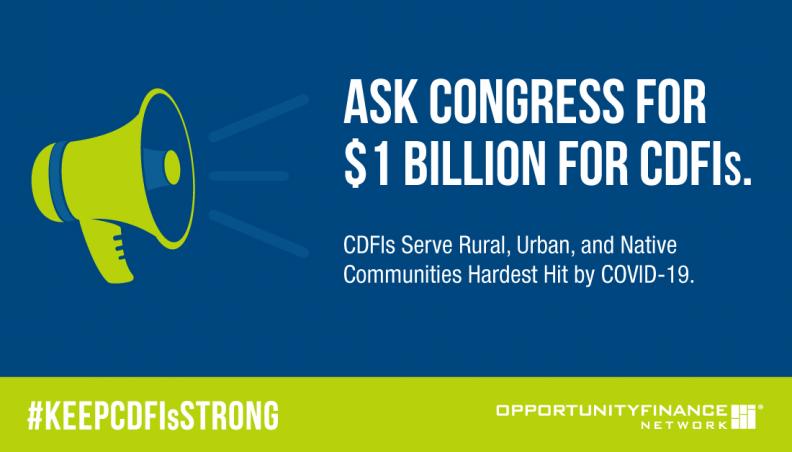CDFIs Call for $1 Billion in New CDFI Fund Grants as PPP Misses the Mark
Mary Scott Balys

Updated April 30, 2020
As Congress begins drafting “Phase 4” legislation to address the continuing health and economic impacts of COVID-19, OFN is strongly advocating for a $1 billion appropriation for the CDFI Fund to administer a rapid response grant program.
This capital will enable CDFIs to reach underserved businesses—many of which were left out of the Paycheck Protection Program (PPP)—and also meet housing, consumer, and other ongoing needs in the communities CDFIs serve.
Join us in taking action by sharing your CDFI’s story with Congress and by participating in our #KeepCDFIsStrong campaign.
Federal response programs like the PPP are not a substitute for critical equity capital that CDFIs need to support medium- and long-term economic recovery.
Paycheck Protection Program Advocacy and Updates
The PPP has been the Trump Administration’s signature program for helping small businesses impacted by COVID-19. Because the program has left out most CDFIs as lenders, the program has failed to reach many small, minority- and women-owned small businesses.
From the outset of the government’s response to the COVID-19 crisis, OFN has worked to include more CDFIs as eligible lenders under the PPP. CDFIs are uniquely positioned to help very small, rural, minority and women-owned, and other underserved businesses access this source of capital.
However, PPP initially stipulated that eligible lenders show $50 million in small business loans annually. The average size of a CDFI’s small business loan is $44,000, so very few meet the requirement and most have been unable to participate in the program.
On April 22, OFN wrote our second letter to Secretary Mnuchin urging him to revise the criteria immediately in the next tranche.
On April 24, the second round of PPP funding was signed into law. Despite our advocacy and Congressional desire for CDFIs to play a larger role as PPP lenders, the legislation didn’t mandate that Treasury change the eligibility rules for lenders and lower the $50 million threshold. This again made it nearly impossible for a significant number of qualified CDFI small business lenders to gain access to the PPP.
Finally, over a month after the program was created and after billions of dollars in loans have been processed, Treasury modified their regulations on April 30 to allow CDFIs with $10 million in business loans or other commercial financial receivables during a 12-month period in the past 36 months to apply to be eligible lenders. With funding set to run out again in a matter of days, this again leaves CDFIs with little real access to the program.
The second PPP agreement did provide an additional $310 billion to the program while allocating additional funds to the Small Business Administration Economic Injury Disaster Loan Program and more resources for COVID-19 testing.
The agreement included a set aside of $60 billion for smaller lenders: $30 billion for loans made by Insured Depository Institutions and Credit Unions with assets between $10 billion and $50 billion; and $30 billion for loans made by Community Financial Institutions (which includes CDFIs and Minority Depository Institutions), Small Insured Depository Institutions, and Credit Unions with assets less than $10 billion.
OFN continues to work with allies in Congress and with partner organizations to encourage Treasury to carve out $10 billion from the set aside exclusively for Minority Depository Institutions and CDFIs.
OFN is also asking the Federal Reserve to give CDFIs access to its PPP Liquidity Facility in order to increase CDFIs’ capacity to make PPP loans.
